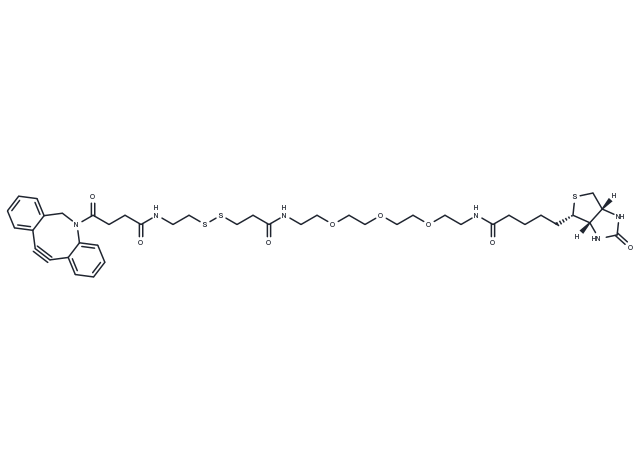store at low temperature
Powder: -20°C for 3 years | In solvent: -80°C for 1 year

DBCO-S-S-PEG3-biotin is a cleavable reagent for introduction of a biotin moiety to azide-containing biomolecules using copper-free Click Chemistry. The disulfide bond in this linker can be cleaved using reducing agents such as DTT, BME and TCEP to remove the biotin label. PEG Linkers can be used in the synthesis of PROTACs.

| Pack Size | Availability | Price/USD | Quantity |
|---|---|---|---|
| 1 mg | In stock | $ 60.00 | |
| 5 mg | In stock | $ 128.00 | |
| 10 mg | In stock | $ 213.00 | |
| 25 mg | In stock | $ 397.00 | |
| 50 mg | In stock | $ 589.00 |



| Description | DBCO-S-S-PEG3-biotin is a cleavable reagent for introduction of a biotin moiety to azide-containing biomolecules using copper-free Click Chemistry. The disulfide bond in this linker can be cleaved using reducing agents such as DTT, BME and TCEP to remove the biotin label. PEG Linkers can be used in the synthesis of PROTACs. |
| In vitro | PROTACs contain two different ligands connected by a linker; one of them is a ligand for an E3 ubiquitin ligase and the other one is for the target protein. PROTACs exploit the intracellular ubiquitin-proteasome system to selectively degrade target proteins[1]. |
| Molecular Weight | 869.12 |
| Formula | C42H56N6O8S3 |
| CAS No. | 1430408-09-5 |
store at low temperature
Powder: -20°C for 3 years | In solvent: -80°C for 1 year
DMSO: 10 mM
You can also refer to dose conversion for different animals. More
bottom
Please see Inhibitor Handling Instructions for more frequently ask questions. Topics include: how to prepare stock solutions, how to store products, and cautions on cell-based assays & animal experiments, etc.
DBCO-S-S-PEG3-biotin 1430408-09-5 Others PROTAC PROTAC Linker inhibit PROTAC Linkers DBCO-S-S-PEG-3-biotin Inhibitor DBCOSSPEG3biotin DBCO S S PEG3 biotin inhibitor
